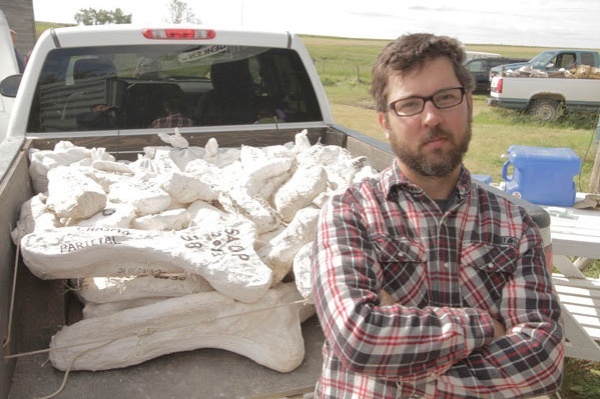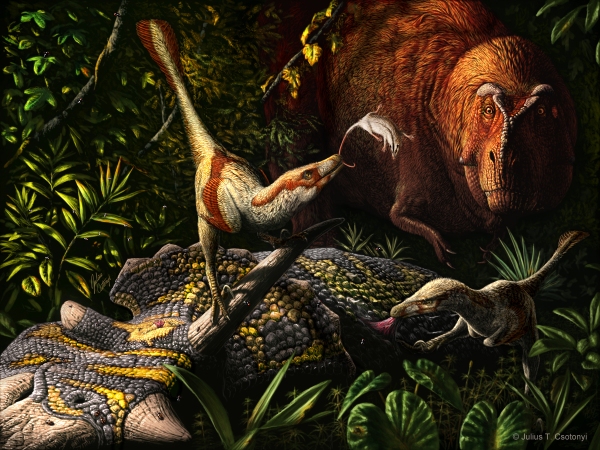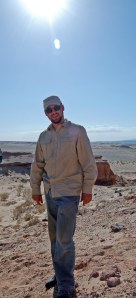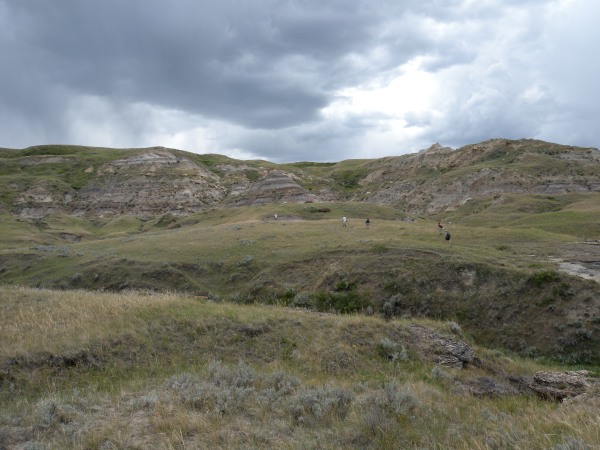Dino Hunt Canada Series Airs on HISTORY Canda
 In the last century, nearly 1,000 dinosaur skeletons have been found in Canada, with more being discovered every year. Canada is one of the best places in the world to trace the evolutionary story of dinosaurs – from their first steps to the peak of their diversity and to their ultimate extinction. Through an exciting multi-platform experience, HISTORY travels coast-to-coast with Canada’s top palaeontologists to uncover how dinosaurs lived – and died – right here at home. Dino Hunt Canada is a new 4-part documentary series that tells the story of six teams of Canadian fossil hunters who discover some of the most important dinosaur finds in the world. Their expeditions take viewers to some of the most stunning locations in Canada, from the red sandstones of Nova Scotia’s Bay of Fundy to the moonscape of the Canadian Badlands in Alberta.
In the last century, nearly 1,000 dinosaur skeletons have been found in Canada, with more being discovered every year. Canada is one of the best places in the world to trace the evolutionary story of dinosaurs – from their first steps to the peak of their diversity and to their ultimate extinction. Through an exciting multi-platform experience, HISTORY travels coast-to-coast with Canada’s top palaeontologists to uncover how dinosaurs lived – and died – right here at home. Dino Hunt Canada is a new 4-part documentary series that tells the story of six teams of Canadian fossil hunters who discover some of the most important dinosaur finds in the world. Their expeditions take viewers to some of the most stunning locations in Canada, from the red sandstones of Nova Scotia’s Bay of Fundy to the moonscape of the Canadian Badlands in Alberta.
The Dino Hunt Canada digital experience (www.dinohunt.ca) provides Canadians with a fun and engaging, cross-platform glimpse into the discovery of a new dinosaur. You can follow its complete journey beginning with the discovery of the fossils in Alberta, through scientific study and restoration via a live-streaming online feed running directly from the ROM’s Dino Lab, all the way to its eventual reconstruction and public display. The website also offers users the opportunity to Ask an Expert – one-on-one access to the palaeontologists and experts from the miniseries, and learn more about Canada’s rich dinosaur history through the Dino Index’s 3D dino models with added images and encyclopedic text. Through the online “Name Our Dino”contest, Canadians nicknamed the new skeleton “Cornelius”.
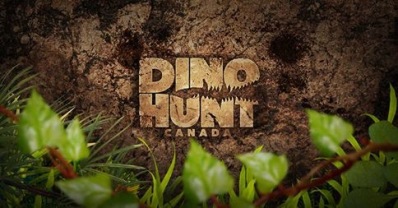
To learn more about Canada’s amazing dinosaur heritage, visit http://www.DinoHunt.ca.
The first episode, features my team from the Royal Ontario Museum (ROM) as we search for the skull bones of what turns out to be a previously unknown horned dinosaur. The newly discovered dinosaur is on display in the New Dino Discovered exhibition, which opened to the public during the ROM’s Dinos Invade! Big Weekend on January 24 and 25. The exhibition features a cast of the new species, as well as information that takes visitors into the field with us as we dig up the fossils.
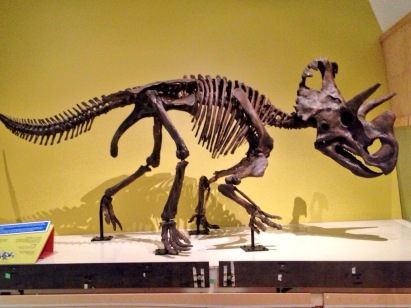
Canada’s newest dinosaur, a yet-to-be named ceratopsian, on display in the New Dino Discovered exhibit at the Royal Ontario Museum
Hear an interview about the new dinosaur discovery here.
To learn more about Canada’s amazing dinosaur heritage, visit www.DinoHunt.ca.
Introducing Mercuriceratops
New Horned Dinosaur Reveals Unique Wing-Shaped Headgear
Today, we annnouce the discovery of a new species of horned dinosaur (ceratopsian) based on fossils collected from Montana in the United States and Alberta, Canada. Mercuriceratops (mer-cure-E-sare-ah-tops) gemini was approximately 6 meters (20 feet) long and weighed more than 2 tons. It lived about 77 million years ago during the Late Cretaceous Period. Research describing the new species is published online in the journal Naturwissenschaften.
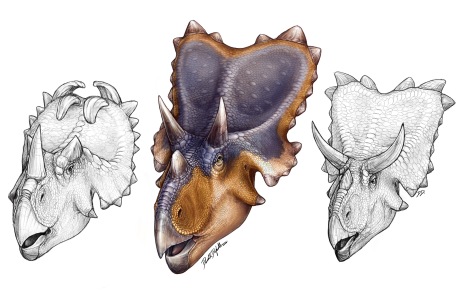
Mercuriceratops (middle) compared to a typical centrosaurine (left) and chasmosaurine (right). Courtesy Danielle Dufault.
Mercuriceratops (Mercuri + ceratops) means “Mercury horned-face,” referring to the wing-like ornamentation on its head that resembles the wings on the helmet of the Roman god, Mercury. The name “gemini” refers to the almost identical twin specimens found in north central Montana and the UNESCO World Heritage Site, Dinosaur Provincial Park, in Alberta, Canada. Mercuriceratops had a parrot-like beak and probably had two long brow horns above its eyes. It was a plant-eating dinosaur.
“Mercuriceratops took a unique evolutionary path that shaped the large frill on the back of its skull into protruding wings like the decorative fins on classic 1950s cars. It definitively would have stood out from the herd during the Late Cretaceous,” said lead author Dr. Michael Ryan, curator of vertebrate paleontology at The Cleveland Museum of Natural History. “Horned dinosaurs in North America used their elaborate skull ornamentation to identify each other and to attract mates—not just for protection from predators. The wing-like protrusions on the sides of its frill may have offered male Mercuriceratops a competitive advantage in attracting mates.”
“The butterfly-shaped frill, or neck shield, of Mercuriceratops is unlike anything we have seen before,” said co-author Dr. David Evans, curator of vertebrate palaeontology at the Royal Ontario Museum. “Mercuriceratops shows that evolution gave rise to much greater variation in horned dinosaur headgear than we had previously suspected.”
The new dinosaur is described from skull fragments from two individuals collected from the Judith River Formation of Montana and the Dinosaur Park Formation of Alberta. The Montana specimen was originally collected on private land and acquired by the Royal Ontario Museum. The Alberta specimen was collected by Susan Owen-Kagen, a preparator in Dr. Philip Currie’s lab at the University of Alberta. “Susan showed me her specimen during one of my trips to Alberta,” said Ryan. “When I saw it my jaw dropped open as I instantly recognized it as being from the same type of dinosaur that the Royal Ontario Museum had from Montana.”
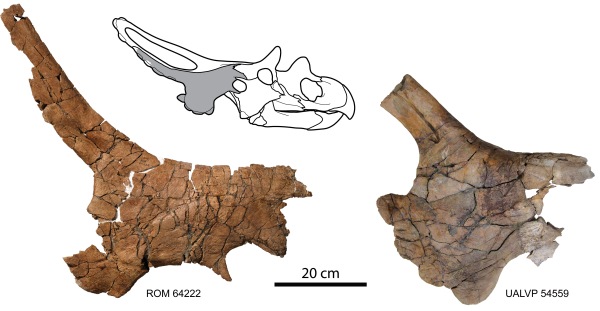
The holotype squamosal of Mercuriceratops from Montana (left) and the referred specimen from Alberta (right)
The Alberta specimen confirmed that the fossil from Montana was not a pathological specimen, nor had it somehow been distorted during the process of fossilization,” said Dr. Philip Currie, professor and Canada research chair in dinosaur paleobiology at the University of Alberta. “The two fossils—squamosal bones from the side of the frill—have all the features you would expect, just presented in a unique shape.”
This dinosaur is just the latest in a series of new finds being made by Ryan and Evans as part of their Southern Alberta Dinosaur Project, which is designed to fill in gaps in our knowledge of Late Cretaceous dinosaurs and study their evolution. This project focuses on the paleontology of some of oldest dinosaur-bearing rocks in Alberta and the neighbouring rocks of northern Montana that are of the same age.
Today we announced the results of a major study on dinosaur body size evolution in a new paper published in PLoS Biology.
From the Press Release: An international, led by scientists at Oxford University and the Royal Ontario Museum, estimated the body mass of 426 dinosaur species based on the thickness of their leg bones. The team found that dinosaurs showed rapid rates of body size evolution shortly after their origins, around 230 million years ago. However, these soon slowed: only the evolutionary line leading to birds continued to change size at this rate, and continued to do so for 170 million years, producing new ecological diversity not seen in other dinosaurs.

Dinosaurs evolved into a huge range of shapes and sizes over 170 million years. Courtesy of Julius Csotonyi.
“Dinosaurs aren’t extinct; there are about 10,000 species alive today in the form of birds. We wanted to understand the evolutionary links between this exceptional living group and their Mesozoic relatives, including well-known extinct species like T. rex, Triceratops, and Stegosaurus,” said Dr Roger Benson of Oxford University’s Department of Earth Sciences, who led the study. “We found exceptional body mass variation in the dinosaur line leading to birds, especially in the feathered dinosaurs called maniraptorans. These include Jurassic Park’s Velociraptor, birds, and a huge range of other forms, weighing anything from 15 grams to 3 tonnes, and eating meat, plants, and more omnivorous diets.”
The team believes that small body size might have been key to maintaining evolutionary potential in birds, which broke the lower body size limit of around 1 kilogram seen in other dinosaurs.
“How do you weigh a dinosaur? You can do it by measuring the thickness of its leg bones, like the femur. This is quite reliable,” said Dr Nicolás Campione, of the Uppsala University, a member of the team. “This shows that the biggest dinosaur Argentinosaurus, at 90 tonnes, was 6 million times the weight of the smallest Mesozoic dinosaur, a sparrow-sized bird called Qiliania, weighing 15 grams. Clearly, the dinosaur body plan was extremely versatile.”
The team examined rates of body size evolution on the entire family tree of dinosaurs, sampled throughout their first 170 million years on Earth. If close relatives are fairly similar in size, then evolution was probably quite slow. But if they are very different in size, then evolution must have been fast.
“What we found was striking. Dinosaur body size evolved very rapidly in early forms, likely associated with the invasion of new ecological niches. In general, rates slowed down as these lineages continued to diversify,” said Dr David Evans at the Royal Ontario Museum, who co-devised the project. “But it’s the sustained high rates of evolution in the feathered maniraptoran dinosaur lineage that led to birds – the second great evolutionary radiation of dinosaurs.”
The evolutionary line leading to birds kept experimenting with different, often radically smaller, body sizes – enabling new body ‘designs’ and adaptations to arise more rapidly than among larger dinosaurs. Other dinosaur groups failed to do this, got locked in to narrow ecological niches, and ultimately went extinct. This suggest that important living groups such as birds might result from sustained, rapid evolutionary rates over timescales of hundreds of millions of years, which could not be observed without fossils.
Open-Access Article:
. 2014. Rates of dinosaur body mass evolution indicate 170 million years of sustained ecological innovation on the avian stem lineage, PLOS Biology 12(5): e1001853.
PLoS Biology Primer:
Moen D, Morlon H (2014) From Dinosaurs to Modern Bird Diversity: Extending the Time Scale of Adaptive Radiation. PLoS Biology 12(5): e1001854
ScienceNOW: How Birds Survived the Dinosaur Apocalypse by Michael Balther
Museum Diaries Dinos ReDiscovered Episode Airs
“Museum Diaries” is a six-part series commissioned by TVO to celebrate the inner workings of the Royal Ontario Museum during its centennial year. “Dinos Rediscovered” embarks on a stunning journey following the ROM Vertebrate Paleontology team on a field expedition to the Alberta badlands to discover treasures from 75 million years ago. This episode also features PM Project Manager Jason French and his team as they carefully deconstruct one of the ROM’s recent dinosaur exhibits, Ultimate Dinosaurs: Giants of Gondwana, and prepares the exhibition to travel to other Museum.
Learn more here.
Season’s Greetings from Santa Claws!
Check out this fun and fanciful holiday ecard from talented paleoartist Danielle Dufault, which incorporates the latest data on the mysterious theropod Deinocheirus mirificus- now revealed to have stayed enigmatic so long due to strong connections with the master of secrecy Santa himself. Awesome job Danielle!
New Hell Creek Dromaeosaurid Described

Holotype maxilla and associated dentary of Acheroraptor temertyorum. Copyright Royal Ontario Museum.
Today we formally announced publication of a new species of a small, meat-eating dinosaur (‘raptor’) based on newly discovered fossils from Montana, USA. Acheroraptor temertyorum is based on associated upper and lower jaw fossils from the Hell Creek Formation of Montana. It was relatively large for a “raptor”, approaching Deinonychus in size, with a long-snouted skull and dagger-like ridged teeth.
Acheroraptor was one of the last non-avian dinosaurs. It lived 67 to 66 million years ago in western North America, in a community that included Tyrannosaurus rex and Triceratops. As such, Acheroraptor gives us a more complete picture of the ecosystem in North America just before the great extinction that marked the end of the Age of Dinosaurs.
The unique ridged teeth of Acheroraptor have been recognized for decades, but the lack of reasonably complete diagnostic material did not permit determination of the taxonomic affinities and evolutionary relationships of the Hell Creek dromaeosaur until now. Interestingly, the jaw bones of Acheroraptor compare more closely to those of Velociraptor and other long-snouted Asian species than those of older North American species. Dromaeosaurid evolutionary relationships and biogeography will continue to be contentious. Phylogenetic analysis based on the dataset of Longrich and Currie (2009) recovered Acheroraptor as a velociraptorine dromaeosaurid, nested within a group of Asian species. The close evolutionary relationship of Acheroraptor to a group of late-occurring Asian species that includes Velociraptor suggests that migration from Asia may have continued to shape North American dinosaur communities right up until the end of the Cretaceous period.
The research describing Acheroraptor was published in the latest issue of Naturwissenschaften:
Evans, D. C., D. Larson, and P. J. Currie. 2013. A new dromaeosaurid (Dinosauria: Theropoda) with Asian Affinities from the latest Cretaceous of North America. Naturwissenschaften 100 (11): 1041-1049. Available online here.
The Press Release from the Royal Ontario Museum can be found here.
Congrats to Dr. Caleb Marshall Brown
Caleb Brown successfully defended his Ph.D. in the Department of Ecology and Evolutionary Biology at the University of Toronto last week. His thesis is entitled “Advances in Quantitative Methods in Vertebrate Palaeobiology: A Case Study in Horned Dinosaur Evolution”. His thesis explores the limits of several quantitative methods in paleobiological research and applies best practices to a pioneering study on centrosaurine ceratopsid evolution based on specimens collected in Dinosaur Provincial Park, Alberta. This study is the first to quantify cranial morphological variation at essentially the population-level (based on huge collections from successive mass-death bonebeds), and employ sophisticated model-fitting methods to assess evolutionary modes in dinosaurs. In the analysis, he finds strong support for morphological stasis in Centrosaurus and Styracosaurus, and finds no evidence for directional evolution in these lineages.
ABSTRACT: Discerning modes and rates of biological evolution and speciation are some of the primary objectives of evolutionary biology. Much palaeobiological work has focused on developing robust methods for testing and fitting evolutionary models to samples of fossils across a stratigraphic or temporal axis, with most analyses centering on marine invertebrates. Recent extensive sampling of dinosaur deposits now allows for testing of evolutionary modes in this clade, a first for large-bodied terrestrial vertebrates. Within dinosaur palaeobiology, the relative roles of anagenesis and cladogenesis in diversification, particularly for horned dinosaurs, are hotly debated. Due to their large sample sizes, well-documented stratigraphic positions, highly diagnostic ornamentation, and monodominant bonebeds (representing populations), centrosaurine dinosaurs from the Belly River Group of Alberta make an ideal model system for testing the predictions of these two divergent evolutionary modes. Despite this unparalleled fossil record, it (as well as most fossil records) is limited by missing data, small sample size, taphonomic biases, and stratigraphic error. In this thesis, I present case studies that attempt to quantify and better understand these limitations, and inform best practices for overcoming them. The first four chapters, utilizing data sets for crocodilians (extant archosaurs) and a model geological system (upper Belly River Group), allow for a better- constrained quantitative evolutionary analysis of the Belly River Group centrosaurines in chapter five. Correlations and time-series analyses of morphology and stratigraphic position of Centrosaurus apertus and Styracosaurus albertensis are used to test for directional trends and evolutionary model fitting. Evolutionary results are robust to multiple simulations of stratigraphic uncertainty, and overlap between the taxa depends on a single locality. Results find no support for anagenesis, and rather are consistent with taxonomic turnover due to punctuated evolutionary events or, more likely, ecological replacement due to habitat tracking.”
Congrats to Caleb on completion of his degree, and I also want to thank him for all of his help in the lab and in the field over the last four years. Caleb is moving on to the position of Elizabeth Nichols Postdoctoral Fellow at the Royal Tyrrell Museum of Paleontology starting in December.
Congrats Nic Campione, Ph. D.
Congrats to Nic Campione for successfully defending his PhD thesis, which he handed in last week. Nic’s thesis was entitled “Inferring Body Mass in Extinct Terrestrial Vertebrates and the Evolution of Body Size in a Model-Clade of Dinosaurs (Ornithopoda)” (see abstract below).
ABSTRACT– Organismal body size correlates with almost all aspects of ecology and physiology. As a result, the ability to infer body size in the fossil record offers an opportunity to interpret extinct species within a biological, rather than simply a systematic, context. Various methods have been proposed by which to estimate body mass (the standard measure of body size) centering on two main methods: volumetric reconstructions and extant scaling models. The latter models are particularly contentious when applied to extinct terrestrial vertebrates, particularly stem-based taxa for which living relatives are difficult to constrain, such as non-avian dinosaurs and non- therapsid synapsids, resulting in the use of volumetric models that are highly influenced by researcher bias. However, criticisms of scaling models have not been tested within a comprehensive extant dataset. Based on limb measurements of 200 mammals and 47 reptiles, linear models were generated between limb measurements (length and circumference) and body mass to test the hypotheses that phylogenetic history, limb posture, and gait drive the relationship between stylopodial circumference and body mass as critics suggest. Results reject these and instead recover a highly conserved relationship that provides a robust method to estimate body mass in extinct quadrupedal tetrapods. The constrained model is then used to derive a mathematical correction that permits the body mass of bipedal taxa to be estimated from the quadrupedal-based equation. These equations thus form the empirical baseline dataset with which to assess the accuracy of mass estimates derived from volumetric reconstructions, which, although subjective, are crucial for interpreting biomechanical and physiological attributes in extinct forms. The models developed through this research provide accurate and consistent estimates of body size in terrestrial vertebrates, with important implications for generating large datasets aimed at reconstructing macroevolutionary patterns of body size in association with changing Earth systems.
Nic has already accepted a postdoctoral post at Uppsala University in Sweden, where he will be working with Drs. Ben Kear and Per Alhberg on Palaeozoic fish diversity and evolutionary dynamics- as well as dinosaur work. All of us in the lab wish him the very best in his new post!
Yesterday, a team of palaeontologists from the University of Toronto, Royal Ontario Museum, Cleveland Museum of Natural History and University of Calgary announced another new dinosaur, Albertadromeus syntarsus, the smallest plant-eating dinosaur species known from Canada. Albertadromeus was identified from a partial hind leg, and other skeletal elements, found in the Oldman Formation near the town of Manyberries in southern Alberta.
Albertadromeus lived in what is now southern Alberta in the Late Cretaceous, about 77 million years ago. Albertadromeus syntarsus means “Alberta runner with fused foot bones”. Unlike its much larger ornithopod cousins, the duckbilled dinosaurs, its two fused lower leg bones would have made it a fast, agile two-legged runner. Approximately 1.6 m (5 ft) long, it weighed about 16 kg (30 lbs), comparable to a large turkey.
The holotype specimen was found in 2009, during a joint fieldwork project conducted by the Royal Ontario Museum and Dr. Michael Ryan of the Cleveland Museum of Natural History.
The paper not only names a new taxon, but documents the the first articulated/associated thescelosaur skeletons from the exceedingly well sampled Belly River Group of Alberta, and provides a census of all thescelosaur specimens collected from this unit to date. The conclusion- their remains are much more abundant than previously recognized, and they were probably a lot more diverse as well. This research also contributes to a growing body of data suggesting preservational biases against the delicate bones of these small dinosaurs, in that they are less likely to be preserved than larger ones because they are destroyed before being fossilized, play a major role in shaping our perceptions of dinosaur ecosystems.
The research was led by Caleb Brown, currently a Ph.D. student in my lab at the University of Toronto, but who completed much of the work as part of his MSc thesis at the University of Calgary under the supervision of Dr. Anthony Russell. The paper was published as the Feature Article in the latest issue of the Journal of Vertebrate Paleontology, which features a reconstruction of Albertadromeus by Julius Csotonyi on the cover.
See the University of Toronto Press Release here.
Full reference:
Brown, C. M., D. C. Evans, M. J. Ryan, and A. P. Russell. 2013. New data on the diversity and abundance of small-bodied ornithopods (Dinosauria: Ornithischia) from the Belly River Group (Campanian) of Alberta. Journal of Vertebrate Paleontology 33(3):1–26. Available for free download here.
Study of pachycephalosaur fossil record hints at higher diversity of small-bodied ornithischians

Life reconstruction of the new pachycephalosaurid from the Milk River Formation, Alberta. Courtesy J. Csotonyi
Today, my research group reported on a new species of pachycephalosaur from Alberta, Canada, in the current issue of the Nature Communications (link here). Acrotholous audeti ( Ack-RHO-tho-LUS) was identified from both newly discovered and historically collected fossils. Approximately 6 feet long and weighing about 40 kgs in life, the newly identified plant-eating dinosaur represents the oldest definitive pachycephalosaur from North America, and possibly the World. Acrotholus provides a wealth of new information on the evolution of dome-headed dinosaurs. Although it is one of the earliest known members of this group, it’s thickened skull dome is surprisingly well-developed for its geological age. More importantly, detailed study of the unique fossil record of dome-headed dinosaurs highlights biases against the preservation of small dinosaur species, and suggests they were probably far more diverse than we currently know.
Acrotholus means “tall dome,” referring to the dome-shaped skull, which is composed of solid bone over 2 inches thick. The species name honors Alberta rancher Roy Audet, on whose land the best specimen was discovered. Acrotholous walked on two legs, and had a greatly thickened domed skull above its eyes, which was used as a visual signal to other members of its species, and may have also been used in head-butting contests. Acrotholous lived about 85 million years ago. The new dinosaur is based on two skull ‘caps’ from the Milk River Formation of southern Alberta. One of these was collected by the Royal Ontario Museum over 50 years ago, but the best specimen was found in 2008 by University of Toronto graduate student Caleb Brown during a field expedition organized by myself and Dr. Michael Ryan of the Cleveland Museum of Natural History.
Small mammals and reptiles can be very diverse and abundant in modern ecosystems, but small dinosaurs (<100 kg) are considerably less common than large ones in the fossil record. Whether this pattern is a true reflection of dinosaur ecosystems, or is an artefact related to the greater potential for small bones to be destroyed by carnivores and natural decay, has been debated. The massively constructed skull domes of pachycephalosaurs are resistant to destruction, and are much more common than their relatively delicate skeletons-–which otherwise closely resemble those of other small plant-eating dinosaurs. Therefore, we argue, the pachycephalosaur fossil record might provide insight into the diversity of small, plant-eating dinosaurs as a whole.
See Acrotholus in 3D via Digimorph: http://digimorph.org/specimens/Acrotholus_audeti/
Read the Press Release here.
Full Reference:
Evans, D. C., R. Schott, D. Larson, C. Brown, and M. J. Ryan. 2013. The oldest North American pachycephalosaurid and the hidden diversity of small-bodied ornithischian dinosaurs. Nature Communications 4:1828. doi:10.1038/ncomms2749
